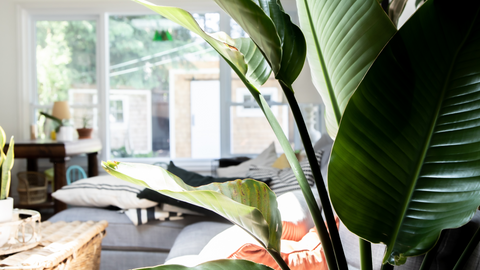Origin Story
The BOP aka Bird of Paradise plant, scientifically known as Strelitzia, originates from South Africa. Strelitzia reginae, a commonly cultivated species and is native to the subtropical regions of the country, where it thrives in open, sunny environments. Recognized for its bird-like flowers, it has gained popularity globally as both an indoor and outdoor plant.

Is a BOP an easy houseplant to care for?
The Bird of Paradise is effortlessly elegant and easy to care for. To achieve tropical vibes place it in bright, indirect light, water when the top inch of soil is dry, and use well-draining soil. Keep it warm, protect from drafts, and occasionally trim dead leaves for a stunning and low-maintenance addition to your space, indoors or outdoors. See that up there ^ new growth!!
What type of sunlight does a BOP require?
Provide your Bird of Paradise (BOP) with bright direct to bright indirect sunlight. To encourage flowering, expose it to direct sunlight during the summer, as it can tolerate up to 6 hours of direct sun. A sun lover at its finest!

How much watering does the BOP plant require?
Water your plant when the soil is dry, adjusting frequency based on its sunlight exposure. In sunny spots during warmer months, increase watering. In the winter, maintain a watering schedule of around every 3 weeks, while in the summer, you can treat it to a refreshing drink up to twice a week.
Bird of paradise can be sensitive to hard water. Try using tap water and allow the plant to get rainwater when it is outside
Does a BOP need humidity?
The Bird of Paradise (BOP) plant is adaptable to a range of humidity levels and does not have specific high humidity requirements. It generally thrives in average indoor humidity levels found in most homes. However, occasional misting or placing the plant in a more humid environment can be beneficial, especially in drier climates or during the winter when indoor heating systems may reduce humidity.
Can I put my BOP outside?
When placing your Bird of Paradise outdoors, wait until the danger of frost has passed and bring it inside before fall temperatures drop. If you notice leaf splitting, don't be alarmed—it's a normal defence mechanism against wind, promoting easier airflow and preventing stem damage. Bird of Paradise plants thrives indoors with controlled temperatures.

Are BOP plants safe for pets?
The BOP is generally considered toxic to pets. It contains compounds that can cause mild to moderate toxicity if ingested.









